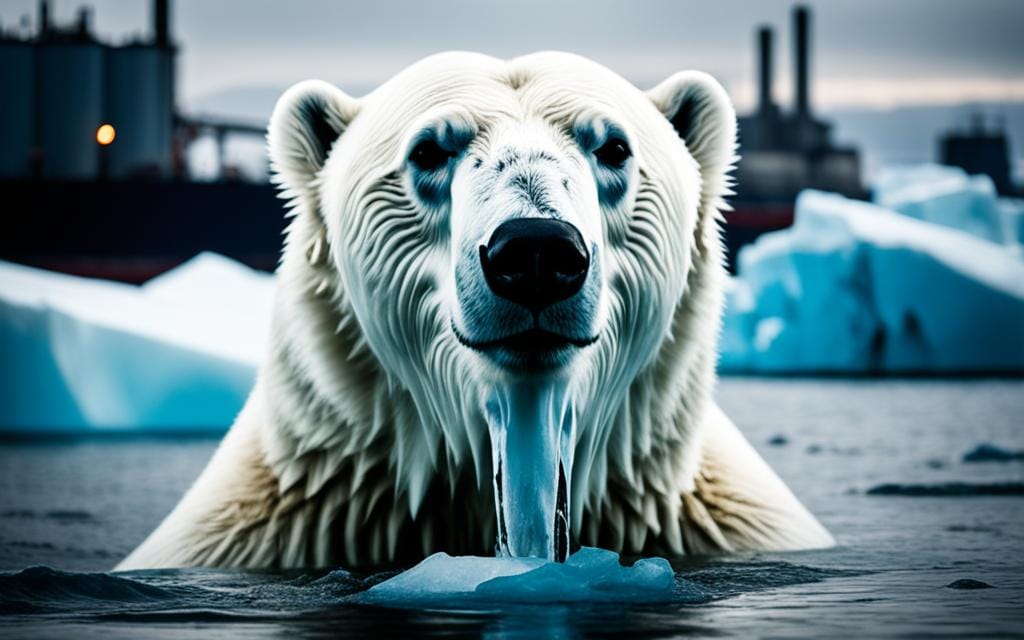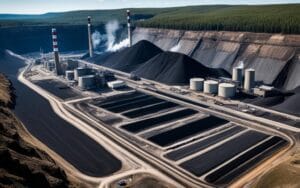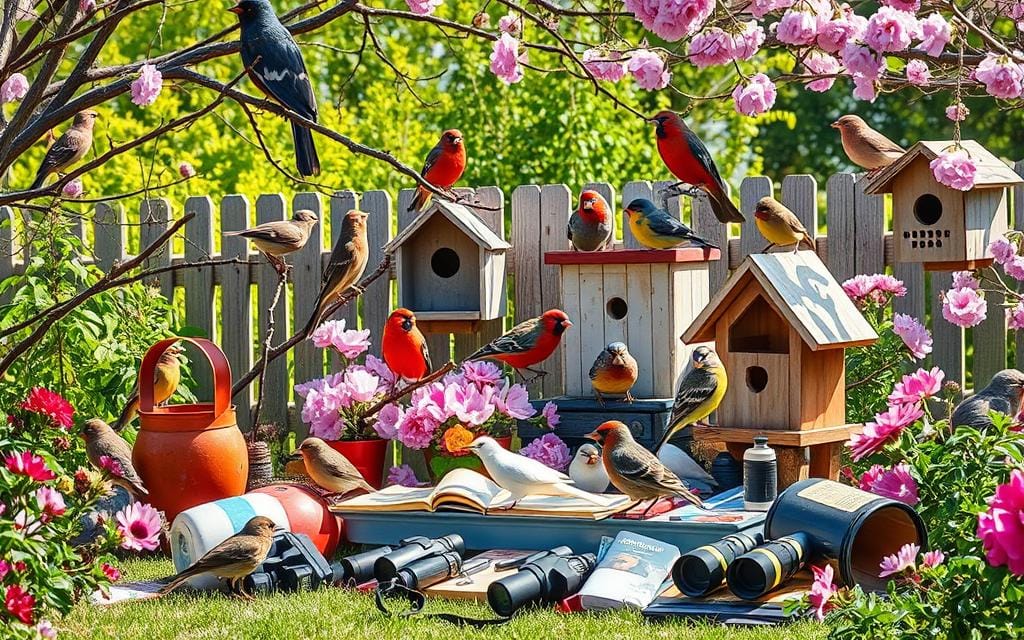How Does Climate Change Affect Animals? As the Earth’s climate changes, we see a huge impact on animals. It leads to rising temperatures, changing migration routes, and loss of homes. There’s also the risk of new species invading. This affects ecosystems, threatening the lives of many animals in the United States1.
Climate change is changing where and how animals live. Rising temperatures push plants and animals to higher places, about 36 feet higher each decade1. The sea is also getting warmer, which changes where and when marine animals reproduce. This messes up the whole sea ecosystem12.
These changes can be very bad. For example, polar bears are now seen as “threatened” because their icy homes are melting fast13. What’s worse, it affects more than just these bears. Changes in migration and the invasion of new species can mean big trouble for lots of animals in the food chain.
Table of Contents
ToggleImpact of Rising Temperatures on Wildlife
The Earth’s temperatures are rising, and this imbalance harms wildlife and their homes4. The planet is now 1.1°C (2°F) warmer than in the 1800s. Global temperatures might rise by 2.7°C (4.8°F) by the end of the century4. Such changes strongly affect native species.
Rising Temperatures and Invasive Species
Warmer conditions help invasive species grow, pushing out native ones5. These invaders can bring diseases that are hard for locals to fight. This lowers biodiversity and hurts their chances of finding food5. The sudden appearance of non-native species is a big danger to local animals and plants.
Native Brook Trout at Risk
Look at the brook trout’s story in Catoctin Mountain Park for a clear picture6. More warmth means less brook trout and more brown trout. A 2017 report by the US Geological Survey showed that brook trout struggle to keep up6.
Climate change upsets the ecosystem’s balance, putting local species like brook trout in danger6. They can’t keep up with invaders that do well in new conditions6. This trend calls for quick action to save wildlife from the effects of warming.
| Impact of Rising Temperatures on Wildlife | Percentage |
|---|---|
| Species facing extinction if action not taken | Up to 60% |
| Increase in carbon in plants, soils, and sediments where wild animals are present | 15-250% |
| Threatened species sensitive to climate change effects | 100% (except Oceanic Whitetip Shark) |
Flooding and Loss of Habitats
Climate change is causing lots of floods, which is hurting wildlife a lot7. For example, sea levels are rising because of it. This puts animals like polar bears and walruses in places they can’t live in7. Sea turtles could lose their beaches with just a 50cm rise in sea level7.
These floods and dry spells are destroying where animals live. They can’t find food or water, so they die7. This affects many, like birds losing their nests in floods. It’s a big problem that’s getting worse because of climate change7.
Wildlife is not only facing floods but also long-term damage7. For instance, in Australia, wildfires in 2020 killed or moved 3 billion animals in a few months7. Flooding causes water to be dirty, hurting fish and other water animals7.
This dirty water messes up the food chain and hurts many species’ homes. Many animals depend on these healthy places to live7.
Habitat loss from floods is a big problem for wild animals. It leads to not enough food for them7. There’s also the issue of deforestation. This lessens the Earth’s ability to stop getting too warm7.
Overall, climate change’s flooding is very bad for wildlife789. It destroys homes and food sources, making it hard for these animals to survive. The problem is only getting worse, and we need to act quickly to protect our planet’s creatures.
Migratory Changes for Songbirds
Climate change is greatly affecting how songbirds migrate long distances. This includes the wood thrush, the official bird of Washington, DC10.
These birds journey each year from Central America to their northern breeding spots. But, rising temperatures are making them lose their living spaces. This makes them go even farther north10. Also, climate change is messing with the timing of ripe fruits and the insect amounts. These are what the wood thrush needs to fuel their trip10.
Wood Thrush Migration
The wood thrush shows us how climate change impacts birds that travel far away10. Studies confirm migratory bird species are showing up in North America two days earlier each decade, starting from the 1990s10. Experts at the National Audubon Society predict many North American birds won’t have enough good living spaces if it keeps getting warmer10.
The wood thrush’s struggle because of climate change is a big worry11. Birds that go long distances are in more danger from climate change than those that don’t. Their set migration patterns make it hard for them to adjust to later fruiting times or fewer insects because of the warming climate11.
Groups are working hard to help the wood thrush and other migrating birds10. They’re doing things like lowering other threats, reducing their own carbon impact, and fixing up their living spaces. These actions can help migratory birds deal with climate change. And keep their beautiful songs echoing in our forests for many years to come10.
Shrinking Habitats for Salmon
Climate change is heavily affecting salmon, a key fish in the US. They are sensitive to water temperatures. Due to warmer temperatures and less water, salmon can’t live in their usual spots12.
For instance, the Chinook salmon in the Sacramento River can’t reproduce well because of high water temperatures. Sadly, about 95% of their young die because of warm water12.
Research shows the Chinook salmon could lose half their river home by 2040. This is due to a 50% drop in water flow13. Over 60 years, streams have become drier and slower. This has led to a 23% loss in where salmon can lay their eggs13.
Less habitat means fewer salmon across the US West Coast. Efforts to fix this, like in the Columbia River Basin, have cost a lot. But, the impacts of climate change are happening faster than we can fix them12. Defenders of Wildlife are working hard. They want to add ways to fight climate change into our plans for nature. Doing this means using less harmful energy and making more clean energy14.
| Climate Change Impact | Effect on Salmon Habitat |
|---|---|
| Warmer water temperatures | Up to 95% of salmon eggs and fry killed in the Sacramento River |
| Reduced river discharge | Chinook salmon could lose nearly half their total habitat by 2040 |
| Decreased summer stream flow | 23% loss of spawning habitat for salmon over a 60-year period |
The impacts of climate change on salmon are alarming. And they have big effects on the whole ecosystem. Salmon show us a lot about the changes happening in our environment. They are like a warning flag for other cold-water fish too, like trout. Defenders of Wildlife are making plans to help. They want to make sure these special fish survive for a long time14.
Animal Health Risks from Invasive Species
The earth’s climate is changing, and animals are moving to new places. This shift allows invasive species to take over new areas, harming native creatures15. These invaders can carry diseases that local animals can’t fight off. This lowers biodiversity and makes a hard time for animals seeking food and space15. Also, because of climate change, diseases that jump from animals to humans are becoming more common. More than half of these diseases have worsened due to the changing climate16.
Some invasive species spread quickly, which is a big worry. The Chinese tallow tree, for instance, went from South Carolina to Florida and then to Texas. This shows how fast these plants can take over new lands15.
In the Northeast region, plants like the Eurasian watermilfoil and the Japanese barberry are problematic. Long Island Sound faces threats from invaders such as the common periwinkle and mitten crabs. There are even some harmful types of red algae there16.
Stopping invasive species needs many actions. We must cut down on greenhouse gases to lessen climate change’s impact. But, building more green spaces and restoring natural habitats are also key.
These steps help protect local wildlife16. Groups like the National Association of Invasive Species Management (NAISMA) work hard to inform people. They also help in spotting, keeping an eye on, and stopping the spread of these intruders17.
The task of handling invasive species and climate change is tough. Yet, we have the power to defend our local wildlife. Knowing about the issues, aiding conservation actions, and changing how we do things with the environment can help. This way, we keep our planet’s diverse life healthy171516.
Phenological Mismatches Disrupting Life Cycles
Climate change is shifting the timing of events like snowmelt, and plant starts. This throws off the schedules of local creatures in various ways. It can mess up ecosystems big time1819.
Example: Snowshoe Hare Color Change
Snowshoe hares changing color with the seasons is a classic example. They turn white to match snow but are putting off this change due to less snow. This makes them stand out more against their surroundings, making them easier meals for predators18.
Because of this, the hares’ ability to hide is going downhill, literally. This shows how a simple thing like changing colors late can have massive effects. It’s a good lesson on how climate change messes with nature’s balance18.
With the environment getting warmer, and rain and snow patterns shifting, many plants and animals are out of sync. This is bad news for the way different species depend on each other. Solving these timing issues is key to helping wildlife deal with climate change19.

The Frontiers 2022 report points out how urgent it is to tackle climate change and loss of biodiversity together. This approach is crucial for fighting off the big environmental problems we face today20.
How Does Climate Change Affect Animals
Climate change is having a big impact on animals in the U.S. Some creatures can adapt quickly, but others find it hard to keep up21. This leads to changes in their travels, the timing of their activities, and how they interact with other animals8.
Many animals face problems because their homes and the surrounding areas are changing8. With rising temperatures and shifting rain patterns, they lose places to find food and safety. This can cause food shortages and more sickness, making life tough for them8.
- Take the pika, for example, a small mammal from the Rocky Mountains21. As summers get drier, there is less grass for them, and they face colder winters with thinner snow21. These changes affect where they live, making it harder for them to stay warm21.
- Animals like snowshoe hares and ermines change their fur color to hide from predators, with the help of sunlight, not just warmth21. But, if winters are shorter, they might not be able to adjust their colors in time, putting them at risk21.
- Black bears might wake up early from hibernation, which can be risky if a cold snap hits21. Even animals like the Canada lynx, with its snow-adapted features, could struggle in a warmer world21.
Climate changes also throw off the balance in nature8. For example, droughts and shorter growing seasons can make food harder to find21. This affects the wellbeing and growth of many species. Mule deer, elk, and pronghorns need safe paths and places to eat in winter, but climate change endangers these areas21.
We must act fast to protect our wildlife from climate change’s harm. By learning how different animals are hit, we can design plans to help them thrive. This way, humans and animals can live together well in the future8.
Impacts on Migratory Birds
Climate change hugely affects migratory birds. It changes their migration paths and impacts the food they need along the way22. Birds must adjust to new weather quickly. If they can’t find food when they arrive, they might have to stop their journey22.
Warmer weather can hurt migrating birds too. Birds might get to their breeding spots too late for bugs. This means they lack the energy they need to move on22.
Timing Mismatches and Resource Scarcity
Climate change’s impact on birds is complex23. More than half of bird species face problems due to climate change and severe weather23. Those that fly shorter distances can deal better than long-distance travelers. The big issue is adapting to the changes in the places they stop22. Years of tracking these migrations inform our understanding. And laws like the Migratory Bird Treaty Act help keep them safe on their journeys22.
As the climate warms, some birds have nowhere to turn. Cities keep growing, but the birds’ habitats shrink. Having safe stopovers during migrations is key for birds. Yet, we’re losing those places to new roads and buildings2223.
| Metric | Value |
|---|---|
| Bird species in Florida | More than 50022 |
| Migratory bird species impacted by climate change | Over 50%23 |
| Bird species projected to see habitat changes in refuges | Approximately 50% by 205024 |
The effects of climate change on birds are serious and pressing. Tackling these problems needs a mix of actions. This includes saving habitats, protecting stopover places, and studying how we can help birds adapt2324.
Mammals Facing Habitat Loss
Climate change is making habitats around the world less suitable for many mammals25. Creatures like those in the Arctic and high mountains are especially affected. They face new challenges because of global warming. This includes hotter temperatures, different rainfall, and more wildfires.
Caribou, Polar Bears, and Others
Caribou and polar bears are losing their homes because of climate change25. Caribou live in the tundra and forests of North America and Eurasia. But as things get warmer and snow patterns shift, finding food and safe space for babies is harder. Polar bears need Arctic sea ice to hunt, breed, and move. But the ice is melting quickly26.
Other animals at risk include mountain goats, bighorn sheep, and pika25. They live in high places and are also feeling the effects of a changing climate26. These animals must adapt or they could disappear. Experts are watching their numbers closely. They’re trying to figure out how to help these precious species survive25.
The struggles of caribou, polar bears, and others show the big impact of climate change26. We need to do all we can to stop climate change. But saving these animals and their homes is just as important27.
Amphibian Population Declines
About one-third of the world’s amphibians are facing extinction risks28. They face unique challenges due to needing both land and water for their life cycles. The main threats to these creatures are climate change and loss of their habitats.
The mountain yellow-legged frog in California’s Sierra Nevada mountains is a clear example. It has vanished from most of its home, 70-90%, in the last few decades28. The reasons include less snow in the mountains and reduced summer rain. This has dried up the ponds where these frogs live and breed.
- Between 2004 and 2022, climate change increased the extinction risk for 39% of amphibian species. In the two decades prior, only 1% was affected this way28.
- Around 93% of endangered amphibians are losing their homes. This is due to things like farming, chopping trees, and building roads28.
- Since 1980, at least 37 amphibian species have disappeared28.
- Salamanders and newts are among the most at-risk amphibians28.
Amphibians find it hard to keep up with quickly changing environments, worsened by habitat break-up28. As the world gets warmer, amphibians might grow smaller. This is a way for them to survive, but it can be hard on them over time29.
Preventing diseases and helping amphibians cope with climate change is crucial for their future28. We need to act fast, investing more and creating better policies to help them thrive again28.
Amphibians are key to keeping ecosystems healthy. They do this by eating bugs and being food for other animals. If their numbers keep dropping, it’s a signal our planet’s health is at risk. Solving the many problems amphibians face is a must to keep our environment in balance.
Marine Life Seeking New Habitats
The world’s oceans are changing. This affects where sea turtles, whales, and fish can live3031. Ocean temperatures are warming. This, along with sea levels rising, changes where marine creatures can find their homes and food31.
Sea Turtles, Whales, and Fish Migrations
Sea turtles are in trouble. Erosion from stronger storms means less area for them to lay eggs30. And, sea turtle egg gender can change with warmer sand. More warmth could mean fewer male turtles30.
Just like sea turtles, whales are facing challenges. They rely on steady migration paths. But, the unpredictability of ice patterns and needing to dive deeper for food make things hard for them32.
Our fish friends are moving, too. They’re searching for cooler waters as ocean temps rise. A scary fact: fishery yields could drop 4% per each degree of warming31. However, changes will show differently in various places. The tropics might lose half of their current fish catch possibilities by 2100. Yet, polar regions might catch more31.
The big picture is about marine life moving because of climate change. This brings huge challenges for keeping ocean life safe and well3132. We must protect the homes and travel paths of creatures like sea turtles and whales more than ever32.
| Impact | Percentage |
|---|---|
| Limit global warming to 1.5°C can reduce risks to marine ecosystems | 31 |
| Decrease in total future fishery yields per degree Celsius warming | ~4%31 |
| Potential loss of catch levels in tropical regions by end of century | up to 50%31 |
| American marine mammal species vulnerable to climate change threats | Over 70%32 |
| Marine mammal stocks in western North Atlantic, Gulf of Mexico, and Caribbean Sea highly or very highly vulnerable | 72%32 |
Conclusion
Climate change is greatly impacting wildlife all over the United States. Migratory birds, Arctic animals, and sea life are all facing challenges. Their habitats are changing and, in some cases, disappearing. Many species find it hard to keep up with the quick shifts happening33. Research shows that warming and acidification of oceans may affect 100% of fish and invertebrates. This is more serious than we thought before33.
If we don’t act soon to cut down on greenhouse gases and aid wildlife, things will get worse. The IPCC warns that 20-30% of plants and animals could go extinct by the century’s end. This is if we don’t control the rising temperatures34. Also, the rates of species disappearing could be faster than what we’ve seen in the past34.
But there’s a bright side. We can make a difference by working together. Protecting forests, wetlands, and farms can help reduce emissions by 1/3 before 2030. This will help keep our planet from getting more than 2°C warmer35. As for us, we can support saving wildlife by cutting down our own emissions. Planting native gardens and keeping our water clean are also big helps. If everyone comes together, we can make sure our wildlife and ecosystems flourish for years to come.
Source Links
- https://www.neefusa.org/story/climate-change/how-climate-change-changing-animal-habits
- https://www.eea.europa.eu/publications/how-climate-change-impacts
- https://populationeducation.org/how-does-climate-change-affect-animals/
- https://www.ifaw.org/journal/impact-climate-change-animals
- https://defenders.org/blog/2023/08/5-ways-climate-change-affects-animals-and-how-we-can-stop-it
- https://www.nps.gov/articles/000/wildlife-climateimpact.htm
- https://onehome.org.uk/topics/find-out-more/further-reading/how-does-climate-change-affect-animals/
- https://www.fws.gov/initiative/climate-change/impacts
- https://www.ifaw.org/journal/animals-most-impacted-climate-change
- https://abcbirds.org/blog/climate-change-impact/
- https://www.worldmigratorybirdday.org/2007/index44cb.html
- https://www.ncbi.nlm.nih.gov/pmc/articles/PMC9344378/
- https://yubanet.com/enviro/climate-change-is-shrinking-and-fragmenting-salmon-habitat-in-the-northwest/
- https://defenders.org/issues/combating-climate-change
- https://www.usgs.gov/faqs/how-does-climate-change-affect-challenge-invasive-species
- https://www.savethesound.org/2023/11/18/climate-explained-impacts-on-wildlife/
- https://www.nisaw.org/climatechange/
- https://climateadaptationexplorer.org/impacts/species/altered-phenology/
- https://www.ncbi.nlm.nih.gov/pmc/articles/PMC2981949/
- https://dialogue.earth/en/climate/climate-change-causing-nature-mismatches-says-un-frontiers-report/
- https://www.nature.org/en-us/about-us/where-we-work/united-states/idaho/stories-in-idaho/winter-animal-adaptations/
- https://www.wusf.org/environment/2023-12-03/climate-change-affects-bird-migration
- https://www.weforum.org/agenda/2023/10/climate-crisis-impacting-animal-migration/
- https://www.fws.gov/story/2023-06/what-migrating-birds-can-teach-us-about-managing-climate-change
- https://www.ucdavis.edu/climate/news/climate-change-threatens-most-amazon-mammals
- https://animalcharityevaluators.org/blog/climate-change-and-animals/
- https://sentientmedia.org/animals-affected-by-climate-change/
- https://abcnews.go.com/International/climate-change-causing-amphibian-populations-decline-higher-rates/story?id=103685473
- https://amphibiaweb.org/declines/climatechange.html
- https://www.marinemammalcenter.org/science-conservation/conservation/climate-change
- https://www.ipcc.ch/srocc/about/faq/final-faq-chapter-5/
- https://www.pbs.org/newshour/science/marine-mammals-in-u-s-waters-are-losing-food-and-habitat-to-climate-change-study-finds
- https://www.sciencedaily.com/releases/2024/04/240409124015.htm
- https://19january2017snapshot.epa.gov/climate-impacts/climate-impacts-ecosystems
- https://www.nature.org/en-us/what-we-do/our-priorities/tackle-climate-change/climate-change-stories/climate-change-frequently-asked-questions/









